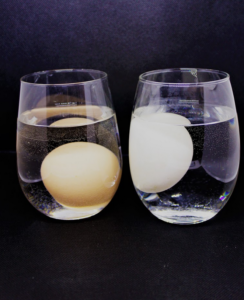How to Tell if a Chicken Egg is Still Fresh

Whether you have store-bought or home-grown eggs, you may find yourself in a situation where you’re not sure if they’re still good. Luckily, there are three simple ways you can use to test if an egg is still fresh.
The Shake Test
To test if an egg is still fresh, the simplest method is to hold it up to your ear and gently shake it. If the egg is fresh, you won’t hear anything. If it’s no longer fresh, you’ll hear it sloshing around. That doesn’t necessarily mean you can’t use it, but if it looks or smells off in any way (see “The cracking test” below), steer clear.
The Float Test
If you don’t feel like shaking an egg, you can put into warm water (uncracked) to test its freshness. It’s best to use warm water for this test—cold water can let bacteria on the shell into the egg. A fresh egg will sink to the bottom and lay flat, lengthwise. A less-fresh-but-still-good egg will sink but stand up on one end rather than laying completely flat. An old egg will float. Really, as long as at least part of the egg is touching the bottom, it should be fine. And actually, older-but-still-fresh eggs are often easier to peel when hard-boiled than super fresh eggs, so that’s a plus.
If you use the float test on your home-grown eggs, make sure to put the egg in the fridge after you do the test. Putting the egg in water will remove its bloom (the shield on the shell that stops bacteria from getting into the egg), so it should not be stored at room temperature after that. Click here for more information about how to store eggs.
The Cracking Test
Finally, you can crack an egg open on a plate to check its freshness. Fresh eggs will have spherical yolks and the egg white will be, well, white. The egg white will also be tight up around the yolk. In an egg that’s older but still fresh, the white will be more transparent. As the egg gets older, the white will also get runnier. When using the cracking test, check the egg’s smell too. If it smells nasty, don’t use it.
You can click the button below to go back to the Farming and Homesteading articles, or you can venture over to the F&H supplies and products we love by clicking the buttons below!
Disclaimer: All information contained herein is intended for educational purposes only. It is not provided to diagnose, prevent, or treat any disease, illness, or injured condition for any human or animal, and Mother Nature’s Truths, as well as the author(s), contributor(s), publishers, and owners accept no responsibility for such use. Anyone suffering from any disease, illness, or injury, or who has an animal suffering from such, should consult with their physician or veterinarian. The statements herein have not been evaluated by the Food and Drug Administration.